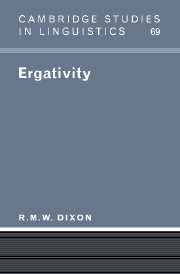Book contents
- Frontmatter
- Contents
- Preface
- Acknowledgements
- Appeal
- List of abbreviations
- 1 Introduction
- 2 Syntactically based and semantically based marking
- 3 Intra-clausal or morphological ergativity
- 4 Types of split system
- 5 The category of ‘subject’
- 6 Inter-clausal or syntactic ergativity
- 7 Language change
- 8 The rationale for ergativity
- Appendix: A note on theoretical models
- References
- Index of authors
- Index of languages and language families
- Subject index
8 - The rationale for ergativity
Published online by Cambridge University Press: 06 July 2010
- Frontmatter
- Contents
- Preface
- Acknowledgements
- Appeal
- List of abbreviations
- 1 Introduction
- 2 Syntactically based and semantically based marking
- 3 Intra-clausal or morphological ergativity
- 4 Types of split system
- 5 The category of ‘subject’
- 6 Inter-clausal or syntactic ergativity
- 7 Language change
- 8 The rationale for ergativity
- Appendix: A note on theoretical models
- References
- Index of authors
- Index of languages and language families
- Subject index
Summary
In this final Chapter I first examine the role of the universal syntactic relations S, A and O in discourse structure, perceiving that S and A are linked in one respect and S and O in another. This helps to explain why there are more examples of morphological ergativity than there are of syntactic ergativity. It also adds to the explanations given earlier for types of ergativity split.
I then focus on what it means for a language to be ergative – whether this carries any implications about the intellectual status or world-view of its speakers (I argue that it does not), or any implications concerning other grammatical parameters. The reasons why some languages are more ergative than others may relate to such things as narrative style, and accidents of historical development. §8.3 summarises some of the main conclusions of this work, and then §8.4 asks what lessons can be drawn, from this survey of ergativity, for our understanding of how language works, and what a linguistic theory should include.
The discourse basis
Categories like ‘ergative’ and ‘accusative’ belong to grammar, that aspect of language which involves definite structures and rules. Recently, attention has been paid to the organisation of discourse. This is a field in which statistical tendencies can be noticed, and quantified, but in which there are no definite constraints.
- Type
- Chapter
- Information
- Ergativity , pp. 207 - 231Publisher: Cambridge University PressPrint publication year: 1994



